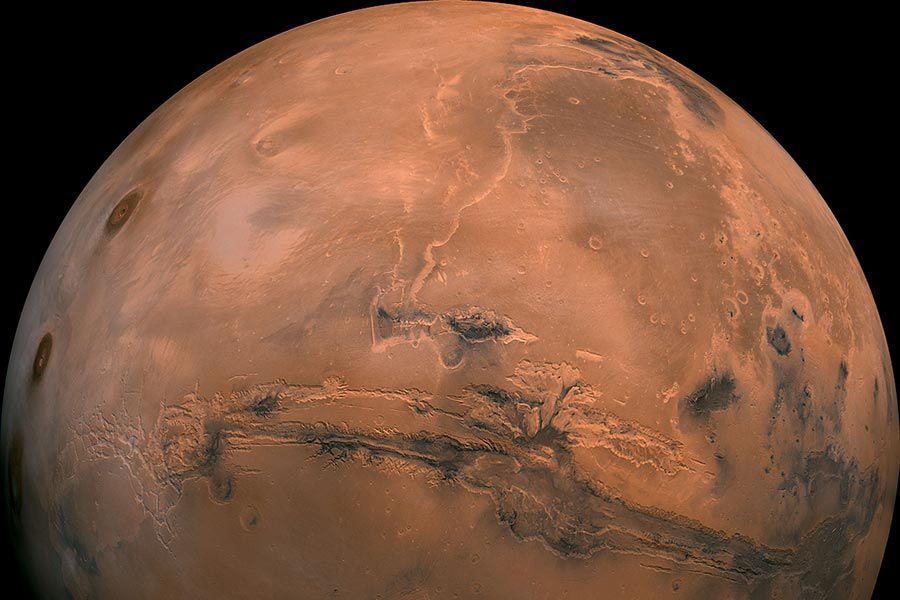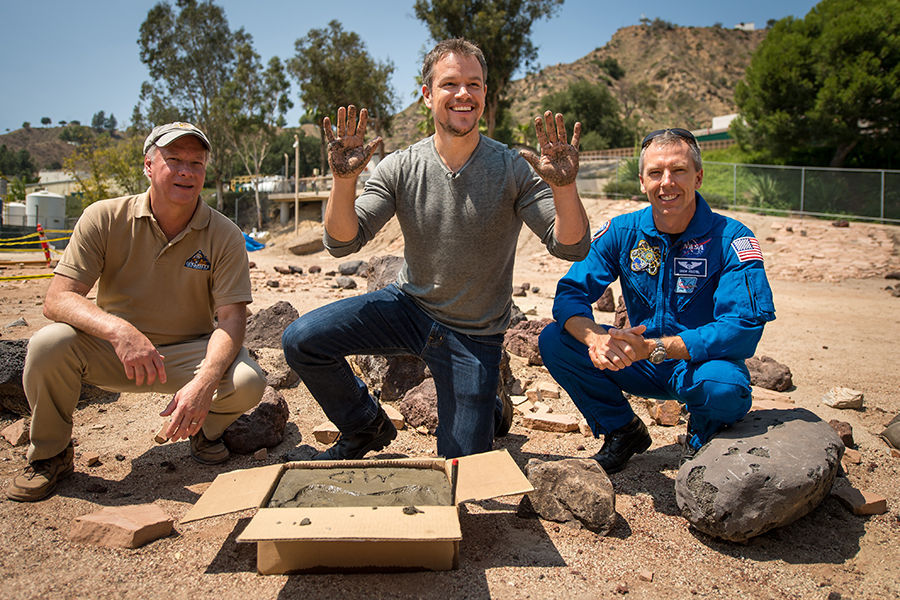Mars Fever

[soliloquy id=”12152″]
Will we find life on Mars…or become “Martians?”
On February 17, 1600, in Rome, Giordano Bruno was burned at the stake for his heresies.
One of his “crimes?” He wrote that the stars were suns like ours and around them might be inhabited planets. He also wrote that the universe was infinite and that the Earth moved—ideas that, in his time, were not acceptable.

Today, a great statue of him stands broodingly above the exact place where he died. We know the Earth does move, even though it doesn’t feel like it when we are standing on it. Our solar system is about two-thirds out from the center of our galaxy, the Milky Way, in a seemingly infinite universe filled with galaxies numerous as grains of sand, and in the last few decades we have confirmed that other planets exist, circling the other suns. They are called exoplanets.
One of these was discovered at Moore Observatory, operated by the University of Louisville and named for Walter Lee Moore, the late professor of mathematics and astronomy. The observatory houses a range of instruments that can be operated remotely, including some in Queensland, Australia. Astronomers don’t often look through telescopes these days. Instead, they use digital cameras to acquire data—like the tiny dip in light coming from a star that indicates a planet has gone in front of it.
The astronomers in Louisville are part of a program called KELT (Kilodegree Extremely Little Telescope), which uses a small, wide-field telescope to look for those slight dips in star brightness. When it finds a likely candidate, the confirmation process falls on the instruments at Moore Observatory, among others.
That’s how Dr. Karen Collins, working on a career in astronomy after retiring as an electrical engineer, confirmed the existence of KELT-6b at Moore Observatory. It is about the size of Saturn, a giant gas ball a long, long way from Earth. She has gone on to help confirm 17 other exoplanets; the odds are about one confirmation in 100 candidates.
“Our objective,” she says, “is to narrow down the candidates to those that are valid with data that can be duplicated by any other astronomer anywhere. Science is all about reproducibility. If the discovery measurements cannot be duplicated, the new exoplanet claim will be challenged by other astronomers.”
Through the internet, from her Louisville home, she can access both the Moore Observatory instruments and a telescope 9,000 feet above the Arizona Desert on Mount Lemmon. She is anxiously waiting for the 2017 launch of a satellite that will help find smaller, Earth-like rocky bodies going around other stars. Out in space, the instruments don’t have to look through the Earth’s turbulent atmosphere.
More than 2,000 exoplanets have been found so far. As of 2014, atmospheres have been discovered on some, and the rotation period has been measured on another—a super-Jupiter’s whose “day” has been clocked at only eight hours long. Astronomers have also confirmed temperatures a few times on a fairly nearby planet: the equivalent of Death Valley at noon in summer. Clouds have been detected and this year, water vapor was found in the air of a supersized Earth. Most of the exoplanets don’t have names other than HD178911 or WASP-94B. No exomoons have been found yet, but they would be very hard to detect.
But what does it all mean, other than proving old Giordano Bruno was right 400 years ago?
“It means,” says Dr. John Kielkopf, professor of physics and astronomy at the University of Louisville, that “suns with planets far outnumber those without. We have once again changed our perspective. We realize that our own solar system is only one among the many.”
And then there’s the “Goldilocks” group. Old Bruno’s last wag of the finger: there may be inhabitants on other planets.
The “Goldilocks Zone” is where a planet orbits its sun at a distance that is not too hot and not too cold, enabling liquid water and air with oxygen to exist: another Earth. There might be as many as 11 billion planets just in our Milky Way—many of them Goldilocks worlds.
Lowell’s legacy
This last of Giordano’s great vision, that life might have happened somewhere else, has stirred our imaginations for centuries. Not long after he died, the telescope was invented. As telescopes became more sophisticated and our knowledge of physics grew, the rest of our solar system was quickly discarded as a place for life. Only Earth and Mars were in the Goldilocks Zone—Mars just barely. It has polar caps that grow and shrink during seasons that are as much as twice as long as ours. The Mars “day” is only slightly longer.
In 1877, an Italian astronomer described dark streaks he saw on Mars as “canali.” In Italian, it just means great grooves, or channels, like the Grand Canyon. But in English it came out canals, associated with artificial construction (the Suez Canal had just been built and the Panama Canal was under construction; canals were in the news) and caused astronomer Percival Lowell to invent the Martians in an 1895 book, and with it, a fascination for the Red Planet that has never ended.
Lowell established an observatory on a hill near Flagstaff, Arizona, in the late 1800s. He saw canals everywhere on Mars, and in best-selling books he described a planet inhabited by a dying race that used the canals to bring water from the polar caps to the desolate, dry deserts. His Mars fed every science fiction author from Edgar Rice Burroughs to Ray Bradbury, whose evocative Martians lounged by canals of lavender wine. Most of all, he made us want to go there.
Until the mid-20th century, Lowell’s Mars legacy remained in the public mind, assisted by movies, most of which featured Martians that weren’t very nice. But other astronomers couldn’t see the canals, and even in Lowell’s time instruments attached to telescopes indicated that neither oxygen nor water vapor existed in the thin atmosphere. Mars was also pretty cold, colder than we had thought and maybe colder than the Earth has ever been. But telescopes on Earth couldn’t make out details on the Mars surface. What was Mars really like up close? Telescopes got traded in for spacecraft, and the first relatively crude fly-bys showed a planet pocked with craters, not unlike the Moon. No canals. No Martians.
The present-day reality
We have by now chucked almost 50 spacecraft at Mars: orbiters to hover over the planet, landers down to the surface to test everything we could test, rovers to roam around the landscape, leaving tracks in the reddish sands. Right now there are seven functioning spacecraft at Mars, studying everything there is to study.
The moon was a dead, airless, savage landscape, alien to us. Mars drew us in with its dead volcanoes—the largest in the solar system—its great canyons, sprawling plains, melting polar caps, winds, dust storms, frost on crater rims, and a land area almost as large as Earth minus our oceans. And there has always been the possibility that something like life exists there. Several of the spacecraft were equipped with programs specifically designed to find it. Our fascination for life elsewhere could mean we are not alone on our vulnerable, blue world.
Perhaps the most amazing recent discovery came in late 2015 when NASA announced that there was briny, flowing salt water in places on the Martian surface. And the discovery of water, whether in the polar caps, under the surface as permafrost, or even occasionally flowing, has dramatically changed the way we think about going there. Early mission plans all used the same scenario: you go there, you come back, just as Stanley did with Livingston, as Dr. Robert Ballard did in exploring the sunken Titanic, as the men who landed on the moon did. You had to take everything with you: rocket fuel, water, food, other supplies, and enough of everything so you could come back. It’s a complex, expensive mission.
Finding water was pivotal, but four technological advances have also changed everything: 3D printing, artificial intelligence in computers, robotics, and private enterprise spacecraft. These have led to the strangest thought of all: maybe we won’t come back. We scrub the back half of the mission. The Vikings who first came to North America long before Columbus didn’t necessarily book a return ticket to Greenland. The passengers in 1620 bound for Plymouth Rock weren’t planning to go back to England.
The atmosphere of Mars can be used to produce oxygen and a buffer gas (the Earth’s air uses nitrogen, but others will do). Water can be turned into hydrogen peroxide for rocket fuel. Robot machines can produce construction materials on Mars, make oxygen from water, and create buildings. Glass and glass fiber are possible and all of the resources are there to make plastics. It now makes more sense to have a “habitat” that could be prefabricated or even manufactured on the planet.
In late 2015, NASA accepted a design for a Mars habitat that proposed a 3D-printed module with a double ice shell around a lander core, called “The Mars Ice House.” There are also lava tubes on Mars that would make almost ready-made habitats—astronauts living in caves, but with oxygen-generating plants that chew up dirt and water. Just don’t put the cat out at night.
One-way visions
While the one-way trip first got some traction with serious mission planners in 1998 and produced Mars-to-Stay concepts, it really got going at the grassroots level in 2010, when a Dutch corporation proposed a one-way manned mission to land in 2027. The company calls going to Mars humanity’s next great adventure, and claims to have galvanized 200,000 people who signed up for the mission from all over the world, hoping to be one of the four astronauts ultimately selected for the first crew. These were narrowed down to 100 finalists last year, one of whom is an American woman with a husband and two stepchildren who are cheering her on. Part of the hoped-for funding for Mars One is expected to come from a reality TV show with a worldwide audience.
The company has been heavily criticized as lacking most of the technology to do what it proposes; Massachusetts Institute of Technology produced a study that said the Mars astronauts would die in as little as 68 days. Even the Mars One CEO admitted that the mission timeline is already two years behind schedule and could fall even further behind, though the corporation is still committed to the program.
The cost estimate at $6 billion has also been questioned. But the critics perhaps miss the point: there has been a huge groundswell of worldwide interest in going to Mars, generated in no small degree by Mars One. Buzz Aldrin, the second man on the moon, has advocated that we should become a two-planet species, and forget going back to the moon. Elon Musk, of PayPal and Tesla car fame, also owns Space-X, a private space corporation. Musk sees a colony on Mars started by about 10 people who would begin a self-sustaining civilization, eventually growing to a population of 10,000. In a final stretch, he has talked about Mars Colony Transports and ticket prices of $500,000 for high-end tourists.
Many engineers believe that the chemical rocket we have depended on for so long will be replaced with a nuclear-powered ship. When that happens, a trip to Mars might take only 30 days, and the ticket price might be in the range of what people spend for a cruise ship ride today. You could see a human bootprint in the rusty soil of Mars by 2030, followed by many more. Who would go on a one-way trip? We don’t have to look beyond our own history. The people who left their homes in Virginia, North Carolina, and elsewhere to struggle through the Cumberland Gap into what we now call Kentucky came to stay.
Why leave comfort in Virginia for the wilds of the west? Because it’s there. And what if we find some kind of life, even if it’s bacteria or moss growing in the Martian permafrost? By then we will have found thousands upon thousands of exoplanets. It could mean that life might be common out there in other solar systems. Just as old Bruno surmised.
Mars in the moviesThe first movie, A Trip to Mars, was a 4-minute piece by the Thomas Edison Company in 1910. The method of travel is a bit creaky: magic powder. The special effects are also rudimentary: very angry trees and a giant, ugly Martian thing. It is available on YouTube.

Eight years later the same title featured travel by spaceship and a Mars inhabited by utopian, peaceful California types, one of the rare Mars films with the planet portrayed as Shangri-La. Most of them feature nasty Martians.
Following World War II and the V-2 rocket, the movies settled firmly on spaceships for travel, often with rubber science for propulsion. Rocketship X-M, made in 1950, features a lunar expedition gone awry and the first female astronaut. The crew lands on Mars to find Stone-Age barbarians who have apparently survived a nuclear war, but lost their civilization. In a sad ending, the female astronaut and the main character, played by Lloyd Bridges, are trapped without enough fuel to safely land on Earth and they burn up in the upper atmosphere.
The Conquest of Space is one of the most realistic of the ’50s movies, done in 1955. Its current-technology feel was heavily influenced by Werner von Braun and the wonderful paintings and illustrations of Chesley Bonestell. It contains the essential idea of real manned missions: a permanent Earth-orbiting space station where assembly of the Mars ship will take place.
In The Angry Red Planet, made in 1959, the astronauts find hostile Martians. The crew does not survive the encounter.
By 2000, when Red Planet was released, no one really believed in Martians, so we became the Martians. The film depicts a female mission commander, strikingly and ably played by Carrie Ann Moss. The plot revolves around “terraforming” Mars, that is, deliberately changing the climate of another planet so humans can live there comfortably. Only two people, including Moss’ character, survive.
John Carter, done in 2012, is probably the most lavish film ever made about Mars. It is a serious adaption of the sprawling soap opera based on Tarzan creator Edgar Rice Burroughs’ 1912 book, A Princess of Mars. In this one, the space travel is a small part of the plot. Unfortunately for the producers and studio, they elected to cut Mars from the title and the film bombed at the box office. It should have been released as John Carter of Mars. Well worth seeing, especially if you like cool special effects and sword fights.
The Martian, released in 2015, is the closest you can come to a fly-on-the-wall look at a real Mars mission. Everything in the film is based on current technology and planning by NASA and others, from the bulky Mars suits to the claustrophobic habitat to trying to survive by growing potatoes in slightly modified Martian soil. The Jordanian desert that provided some of the exterior shots so closely resembles the Martian surface that it might as well be the real thing.
Finally, there is the magnificent Martian Chronicles by the late Ray Bradbury, whose books about Mars and Martians evoked a haunting, lyrical planet. The TV miniseries aired in 1980, but the writing is better.
Practice makes perfect for Mars—somedayIn March 2016, a group in the Netherlands succeeded in growing tomatoes, peas, rye, garden rocket, radishes, and watercress in simulated Martian soil. In the book and movie, The Martian, the stranded astronaut grew potatoes in the Martian soil, which was fertilized with human waste.
All of this earnest experimentation shows that future astronauts could build greenhouses in which they could grow their own food; they don’t have to truck it all the way from Earth. If you’d like to try growing vegetables in Martian dirt, simulated soil is available from Orbital Technologies Corporation for $25 for a 2-pound bottle, and a little over a hundred bucks for a 10-pound sack. It’s an innocent hobby, if a bit eccentric. I’m going to try miniature red roses myself, red roses for the Red Planet. Why not?
Going to Mars using our present means is a long voyage of seven to nine months, best taken when the planet is closest to the earth. Experiments and simulations of long-duration space travel are called Confined Environment Psychology. Five years ago the Russians, along with others, ran a set of experiments in Martian living in which the final stage was a 520-day mission replication. The latter drew 6,000 applications from 40 countries for the six available places.
Just last year, a female Italian astronaut spent almost 200 days in space and a male astronaut recently returned after a year aboard the space station.
NASA has built a simulated Martian habitat on a Hawaii’s Mauna Loa volcano, where a mixed crew of astronauts was scheduled to spend a year in a 1,000-square-foot dome. If they go outside, they do so in spacesuits. They get 8 minutes of total shower time per person per week and dehydrated food to eat. Their communication with the outside is delayed, just as it would be if they had landed on Mars. (Even at the speed of light, radio can take up to 20 minutes one-way from Mars. Screaming arguments would get boring.)
These simulations are important; we need practice. The Earth recycles everything for us, but Mars doesn’t. Living on Mars, we will have to learn to recycle everything: food, water, air, and human waste.
About the author
Robert M. Powers is a native Kentuckian whose ancestors came through the Cumberland Gap before statehood. Decades ago, he “escaped” to the West Coast and then to Europe. Six years ago, he returned to Kentucky, he says, “for want of a better plan.” Both his grandfather and father studied astronomy as a science elective in college, the latter at Eastern Kentucky University. As a child, he became fascinated with photos of Mars in his father’s old astronomy textbook and has been hooked on the Red Planet ever since.

Powers received his first professional magazine assignment from the late John W. Campbell of Analog magazine. The article was about Mars and what might live there, including the germs that might survive the harsh Martian conditions. Long an observer through telescopes—he has even used Lowell’s famous telescope on Mars Hill in Flagstaff, Arizona, to study Mars—Powers shifted his interest to spacecraft when the first unmanned missions to Mars were flown.
Educated at the University of Edinburgh, Scotland, and universities in the U.S., Powers was elected a Fellow of the Royal Astronomical Society of England. He was elected an honorary member of the American Society of Aerospace Pilots, airline pilots who were training to fly the space shuttle; honorary because he was not a commercial airline pilot. He is a three-time winner of the Aviation Space Writers Association writing award and other writing awards.
Powers has published six major nonfiction books, all but one about astronomy or space travel.
His 1986 book, Mars: Our Future on the Red Planet, contained plans and speculations about living on Mars. Taking advantage of information since then that has come from spacecraft, landers, and rovers, Powers’ newest book on Mars is expected to be out in late 2016.
• Want more? Click here to read Mars Mission: Equal Opportunity.

